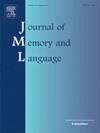在结构持久性中,动画和主题角色的相互作用
IF 3
1区 心理学
Q1 LINGUISTICS
引用次数: 0
摘要
人类句子生成模型经常提出句法和语义过程之间的明确区分。我们通过调查主动-被动结构启动中动画和主题角色之间的相互作用来检验这一假设。研究1发现,前句(启动句)的主动或被动结构会影响后句(目标句)的结构选择。当启动句和目标句在主位角色中具有相同的活力特征时,这种启动效应会增强,从而影响启动主语活力的持久性。动词重复可增强主-被动启动效应,但词汇重复对启动主语活力的持久性没有影响。研究2和研究3表明,主位角色的重复活泼特征增加了英语裂隙结构中主位角色顺序(如在It was the thief that chase the lorry中保持主体优先顺序)和主位结构(如指定主体为主语)的可能性。在日语陈述句中,小品句表示句子的主题,重复的动画表现为论点结构的持久性增强,而不是主位角色顺序的持久性。这些发现表明,主题角色动画重复通过强化主题强调来促进结构启动。本文章由计算机程序翻译,如有差异,请以英文原文为准。
The interplay of animacy and thematic role in structural persistence
Models of human sentence production often propose a clear distinction between syntactic and semantic processes. We examined this assumption by investigating the interaction between animacy and thematic roles in active–passive structural priming. Study 1 found that the active or passive structure of a preceding sentence (prime) influenced structural choice in a subsequent sentence (target). This priming effect increased when the prime and target sentences shared the same animacy features in their thematic roles, which affected the persistence of the prime subject’s animacy. While verb repetition enhanced active–passive priming, the persistence of the prime subject’s animacy was not affected by lexical repetition. Studies 2 and 3 demonstrated that repeated animacy features in the thematic roles increase the likelihood of preserving both the thematic role order of the prime (e.g., maintaining the agent-first order in It was the thief that chased the lorry) and its argument structure (e.g., assigning the agent as the subject) in English cleft constructions. In Japanese declarative sentences, where particles indicate the sentential topic, the repeated animacy features strengthened argument structure persistence but not the persistence of thematic role order. These findings suggest that thematic role animacy repetition boosts structural priming by reinforcing thematic emphasis.
求助全文
通过发布文献求助,成功后即可免费获取论文全文。
去求助
来源期刊
CiteScore
8.70
自引率
14.00%
发文量
49
审稿时长
12.7 weeks
期刊介绍:
Articles in the Journal of Memory and Language contribute to the formulation of scientific issues and theories in the areas of memory, language comprehension and production, and cognitive processes. Special emphasis is given to research articles that provide new theoretical insights based on a carefully laid empirical foundation. The journal generally favors articles that provide multiple experiments. In addition, significant theoretical papers without new experimental findings may be published.
The Journal of Memory and Language is a valuable tool for cognitive scientists, including psychologists, linguists, and others interested in memory and learning, language, reading, and speech.
Research Areas include:
• Topics that illuminate aspects of memory or language processing
• Linguistics
• Neuropsychology.

 求助内容:
求助内容: 应助结果提醒方式:
应助结果提醒方式:


